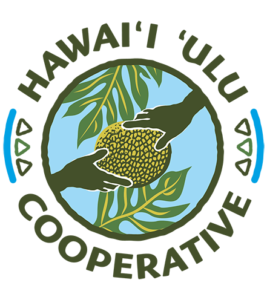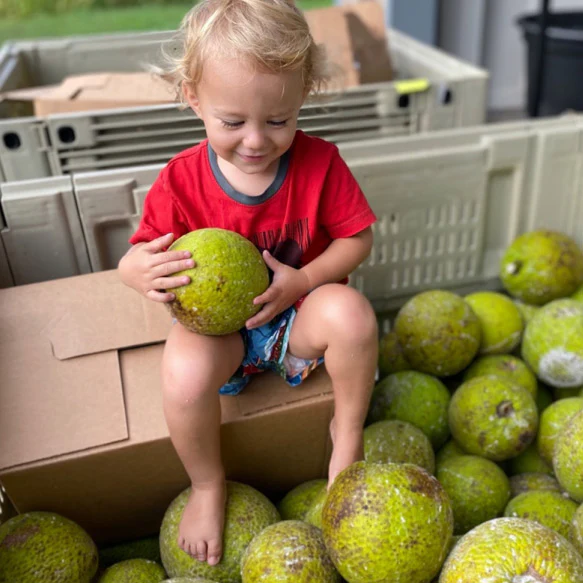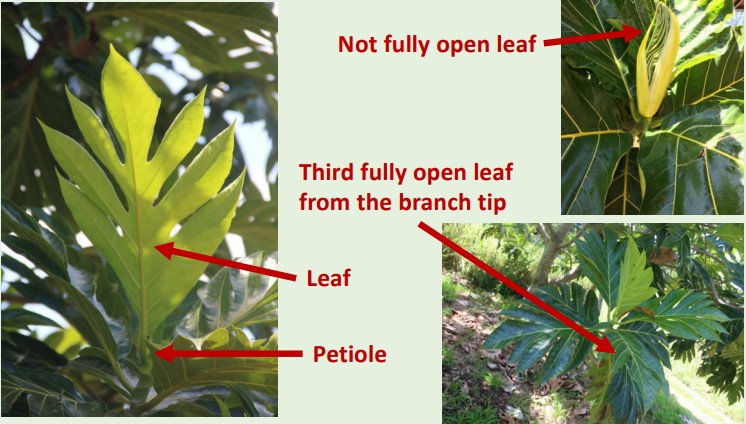Nutrient Management for Breadfruit Production
Curious on how best to feed your ‘ulu trees? Review this helpful PDF which covers an overview of recommended nutrient management practices for selecting a successful fertilizer regimen!
Produced by the University of Hawai’i at Mānoa College of Tropical Agriculture and Human Resources, supported by Western SARE
This document provides an overview of nutrient management practices and strategies for deciding when and how to fertilize your breadfruit trees for high quality and quantity of production. Fertilization is considered to be any action that increases the nutrient availability of soil for tree health, productivity, and longevity.
Fertilization Overview
Fertilization is typically the application of various inputs to the soil or directly to the plant in order to increase the nutrient delivery to plants for increased production. This primarily includes the six major macronutrients and a number of micronutrients (see below). The macro nutrients are in much higher demand than the micronutrients, with nitrogen, phosphorus, and potassium being the most utilized nutrients.
Macro Nutrients
Nitrogen (N)
Phosphorus (P)
Potassium (K)
Calcium (Ca)
Sulfur (S)
Magnesium (Mg)
Micro Nutrients
Iron (Fe)
Boron (B)
Zinc (Z)
Copper (Cu)
Molybdenum (Mo)
Nickle (Ni)
Manganese (Mn)
Chlorine (Cl)
Standard fertilizers report the concentrations of the three most essential nutrients using the convention N-P-K. So a 10-5-30 fertilizer will contain 10% nitrogen, 5% phosphorus, and 30% potassium by weight.
Conventional Fertilizers
Conventional fertilizers are concentrated, often synthetically created, chemical salts that dissolve into available nutrient forms
Organic Inputs
Organic fertilizers are any natural source of nutrients such as manure, compost, or ground minerals.
Foliar Sprays
Liquid fertilizers are water soluble nutrients that are sprayed directly on the plant for immediate uptake through the leaves.
Breadfruit Nutrition
Breadfruit has a very high cation demand (K, Ca, Mg) that manifests both in the vegetative growth and the fruit production. These are fairly mobile elements that in most natural settings are leached from the soil more rapidly than most other elements. These nutrients are very important for the quality and quantity of fruit. Breadfruit is also a soft wooded, very fast growing tree. Nitrogen (N) is the key element in vegetative growth. We suggest cautiously applying nitrogen in order to limit tree growth. Observations suggest that too much nitrogen reduces fruit production as the tree over allocates to leaf and branch production. The remaining nutrient have a moderate demand, requiring relatively low phosphorus (P). Of the micronutrients, only boron and zinc appear to be occasionally limiting, manifested most in smaller leaf size.
Nitrogen, on the x-axis, affects photosynthesis below a critical level (about 2.4%), but above the critical level has no additional positive effect.
Suggested Application
Breadfruit has a nutrient requirement profile very similar to bananas, which are notoriously heavy feeders. We suggest a moderate nitrogen and high potassium mixture, along with relatively high calcium and magnesium. For the macronutrients, we suggest a ratio of 8-5-30 (N-PK) and 5-5-2 (Ca-Mg-S). A reasonable target production per tree 500 lbs per year. At this production rate, the replacement value of nutrients (to replace the nutrients that were removed by fruit harvest) equals:
3.2 lbs nitrogen
– 1.25 lbs phosphorus
– 9.85 lbs potassium
– 1.5 lbs calcium
– 1.3 lbs magnesium
– .60 lbs sulfur
Fertilizer Recommendations (we do not endorse any specific brand, but there are options identified and available in Hawai’i). Recommend splitting total into at least 2-4 applications spread out over a year.
Organic Fertilization A simple organic option is Bioflora Crumbles (6-6-5 plus calcium) and KMag in a 3:2 ratio. Replacement value would be 88 lbs (53 lbs Bioflora and 35 lbs K-Mag).
Conventional Fertilizer In Hawai’i, a simple conventional combination is Wolfkill (10-5-29) and dolomite in a 4:1 ratio. Replacement value would be 40lbs (32lbs Wolfkill and 8 lbs dolomite) per tree per year.
Foliar Nutrient Analyses
Foliar testing can be conducted to make targeted nutrient management decisions. To test foliar nutrients, you will harvest 3-4 leaves from around the tree. Harvest only sun-exposed leaves in the mid-canopy area. Harvest only the 3rd fully open leaf from the branch tip. Remove the petiole (leaf stem) of the leaves and place petioles in a paper bag or envelope, making sure to keep them free of dirt or grass. Submit the petioles to an agricultural diagnostics lab for analysis. See table below for suggested nutrient concentrations to determine if your tree is above or below optimal.
HUC Members: Read more about our HUC Member Soil & Tissue Testing Policy




